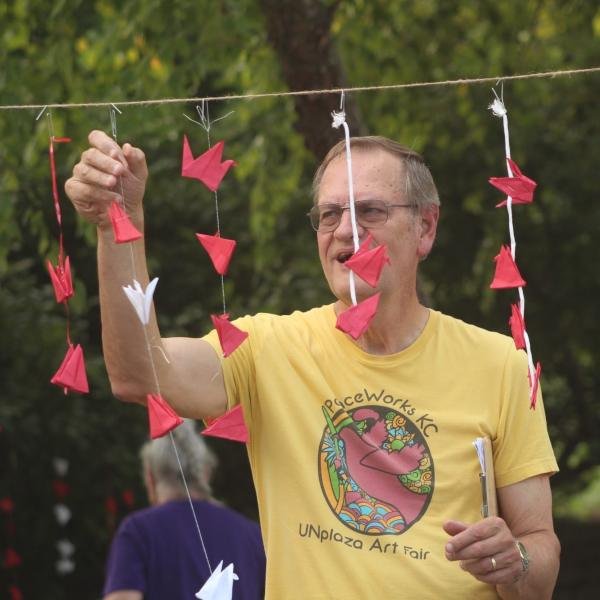As the daily news indicates, the US continues using drone warfare to seek out and kill terrorists … and many of the targets and others killed are in no way terrorists. With that in mind, PeaceWorks-KC members, a local member of Veterans for Peace, and others protested drone warfare at the entry of Whiteman Air Force Base on Nov. 29. “Don’t Look Away” was our theme, and the theme for 10 other peace actions that day at US Air Force bases.
A photo album, complete with captions, gives you a taste of our Whiteman witness. Kriss Avery took the photos. Featured speaker Brian Terrell, a drone activist from Maloy, Iowa, said the US military mistakenly identified Zemari Ahmadi as a terrorist and killed him, seven children, and two others in Kabul, Afghanistan, with a Hellfire Missile shot from a drone into the Ahmadi courtyard on Aug. 29. The Nov. 29 “Don’t Look Away” protests called attention to that tragedy. We mourned that the US drone killings have been confirmed in the past to slay 9 innocent persons for every intended target. Terrell said not only did the US military misidentify Ahmadi as a terrorist—he worked for a California-based charity—but the water bottles Ahmadi put in his car to take to his family were misconstrued as gas cannisters. The US drone attack killed Ahmadi along with the 9 family members who came outside to welcome him home.

Ron Faust, left, and Jonne Long approach the gathering (eventually 14 persons) protesting drone war operations at Whiteman AFB, near Knob Noster, Mo., on Nov. 29. 
The day of protest brought peace activists to 11 air force bases. PeaceWorks-KC members, plus others, gathered at Whiteman AFB’s Spirit Gate, named for the B-2 Spirit Stealth Bomber, capable of making nuclear attacks. 
The B-2 Spirit Stealth Bomber sits on display near the roadside of Whiteman AFB. 
A different definition of Spirit? Speakers noted that the name of the entry gate for Whiteman AFB refers to the B-2 Spirit Stealth Bomber, not the Holy Spirit or a spirit of love. 
“Drones Kill Children,” a sign PeaceWorks-KC has used for 7-9 years, was borne out in the Aug. 29 killings of youngsters aged 2, 3, 6, 7, 10, and 16—and US government documents indicate drones kill persons other than the intended target 90 percent of the time. 
Henry Stoever, right, says he is “proud to be present to what is going on and say, ‘Not in my name! Not in my name!’” 
Mary Hladky, left, and Bennette Dibben stand for peace outside Whiteman AFB. 
Ron Faust shares ideas from his poem “Mistaken Priorities,” noting, “Technology eventually produced Drones / Secret weapons aiming missiles from afar / Except innocent bystanders are wasted.” Ron quoted Amos: “Let justice roll down like waters!” Ron had opposed drone warfare in 2012 at Whiteman and was sentenced to 5 years on probation (soon reduced to 1 year). 
Brian Terrell says Zemari Ahmadi, who worked for a California-based food charity in Kabul, had put water bottles into his car for his family, but those were feared to be gas cannisters. On his arrival home, the family came out to greet him, which is when the US obliterated him and his family. 
Brian Terrell says that on Aug. 29, the US military mistakenly identified Zemari Ahmadi as a terrorist and killed him, seven children, and two others with a Hellfire Missile shot into his courtyard. 
Brian Terrell, Bennette Dibben, Ron Faust, and Jonne Long witness for peace. 
Jeff Stack, at center, speaks with Ann Suellentrop—both are longtime peace activists. 
Brian Terrell of Maloy, Iowa, holds the “Ground the Drones” sign. His history of drone opposition includes many journeys to Afghanistan and many civil resistance “offenses” in the US, including a 2012 protest at Whiteman AFB for which he spent 6 months in prison—officers arrested him for simply trying to give them a letter to the Whiteman commander objecting to drone warfare. 
For awhile, we faced the traffic with our signs and the Vets for Peace flag. 
Chris Overfelt, left, holds the Veterans for Peace flag. He regretfully acknowledged his part in the Afghanistan war; he served in the US Air Force from 2002 to 2011. 
Behind Jon Schafer and Mary Hladky is housing for Air Force officers and families. 
Jon Schafer, left, and Mary Hladky hold signs near the road on which cars occasionally gunned their motors to drown out our speakers’ message. 
Ann Suellentrop, at right, designed the poster she holds, plus the four-panel display, “Don’t Look Away.” Ann talks with Jeff Stack of the Mid-Missouri Fellowship of Reconciliation, based in Columbia. From the left are Brother Louis Rodemann, Kristin Scheer, and Sister Theresa Maly. 
“Don’t Look Away,” the theme for protests at 11 US Air Force bases on Nov. 29, commemorates members of the Ahmadi family killed by a US drone Aug. 29. 
Ann Suellentrop—nuke-and-drone protester, retired nurse, and artist—holds one of her signs while Bennette Dibben takes pictures. 
“Welcome to Whiteman,” says the sign, but PeaceWorks-KS folks were not permitted to park in the nearby Visitors’ Center lot. 
Peace activists converge at Whiteman AFB, where officers conduct remote-control combat missions with MQ-9 Reaper drones. The Aug. 29 attack in Kabul, Afghanistan, was carried out by an MQ-9 Reaper drone, but the Air Force won’t identify the base from which that drone was directed, says Brian Terrell. 
Mary Hladky, left, and Brother Louis Rodemann walk about half a mile to the Whiteman AFB entry. 
Jeff Stack of the multi-bumper-stickered car arrives for the drone protest from Columbia, Mo.
Photos by Kriss Avery.

